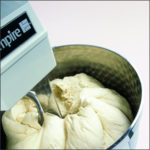Great Baking starts with a Great Mixer
Next to the oven, the mixer is perhaps the most important piece of equipment in your bakery today. All of your wonderfully delicious products start their journey right there in the mixing bowl. Selecting the right mixer for your business is key to the production of consistent, high quality products.
Planetary Mixers
The first commercial mixer was invented in 1908 by Herbert Johnson, an engineer working at the Hobart Manufacturing Company. Designed to emulate the stirring motion of a bakers hand, this "planetary" design drives the mixing arm in an orbital fashion around the mixing bowl as it turns. The planetary mixer's ability to utilize a variety of mixing attachments make it extremely versatile, allowing a baker to mix everything from cake batters to dough. By 1915 Hobart's 80 quart planetary mixer was standard in most commercial bakeries around the country and to this day it remains a popular choice for many bakers. The planetary mixer is not without its limitations however. Its orbital design and stationary bowl creates friction and the heat generated can be a problem for dough based products such as pizza, bagels, and breads.
Horizontal Mixers
For many years, the horizontal mixer has been a popular choice for intermediate to large wholesale bakeries. This design consists of a large cylindrical barrel that can house several different type mixing arms depending on the product. Horizontal mixers are known for their massive strength as they are capable of churning thousands of pounds of dough at a time. Once the mixing cycle is complete the dough can be easily discharged into a dough trough for transportation. These machines originally gained popularity in the white bread plants. Later as demand for pizza, middle eastern breads, bagels and a variety of European style bread products grew horizontal mixers became more popular in ethnic bakeries as well. A drawback of the horizontal mixer, however, is the amount of heat generated by the dough rubbing against the side wall of the mixing chamber which can be damaging to some doughs.
Spiral Mixers
Long used in Europe, Spiral Mixers began making inroads into American Artisan bakeries in the 1960’s - although they did meet with some initial resistance. In the past 50 years, however, the popularity of Spiral Mixers has grown tremendously. Utilizing a fixed position spiral mixing arm with rotating bowl Spiral Mixers are known for both minimizing dough punishment and their flexibility. Strong enough for bagels and gentle enough for ciabatta and French dough, Spiral Mixers are a popular choice for a wide array of bakeries - from retail bagel shops to Artisan bread bakeries, large commercial bread plants and everything in between. Overall, Spiral Arm Mixers offer several advantages to the discerning baker:
DOUGH QUALITY
The spiral mixing arm, center breaker bar and rotating bowl work in unison to move the dough in and out of the mixing zone. This results in a much more gentle blending action than a planetary or horizontal design. It also creates a much lower friction factor minimizing the amount of heat generated by the dough rubbing against the bowl. As a result the dough can be more fully developed before it reaches critical temperature.
ENERGY EFFICIENCY
The Spiral Mixer's lower friction factor also equates to a lower overall electrical resistance. This lower resistance, coupled with an efficient distribution of energy between the driving motor and spiral mixing arm, allows the Spiral Mixer to consume much less energy than a comparable horizontal unit.
FLEXIBLITY
Spiral Mixers are available in a wide range of sizes and configurations. The most popular stationary models are available in dough capacities from 50-1000 lbs or more. Removable Bowl and Tiltover Spiral Mixer designs allow for a variety of discharge options - onto tables, into dough troughs as well as into elevated hoppers. Additionally, Spiral Mixers have the ability to mix doughs that are much smaller than the rated capacity of the machine. For example, a spiral rated at 660 lbs of dough can be used to mix as little as 100 lbs or less. This isn't possible in many equivalent counterparts.
COST
A Tiltover or Removable Bowl Spiral Mixer can cost as little as a third of a comparably sized horizontal mixer, but the cost benefits don't stop there. As with any piece of equipment, a quality-made Spiral Mixer will be durable and reliable offering you years of maintenance free operation.
With all of the benefits that they offer, it's easy to see why Spiral Mixer popularity has grown so tremendously in the industry. Still, a Spiral Mixer is not the optimal choice for all products. While it may be ideal for Artisan breads, bagels, pizza and other quality bread products, a spiral mixer would not be the best choice for products like cake batters, muffins or meringues.
As you can see, there is no one-size-fits-all mixing solution. Selecting the right mixer requires an intimate knowledge of your product and your production needs. Working with a qualified equipment representative will help ensure that you find the perfect fit for your mixing needs. After all, great baking starts with a great mixer!

